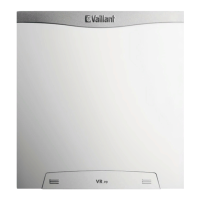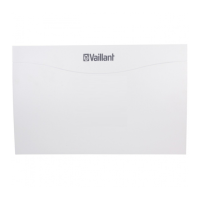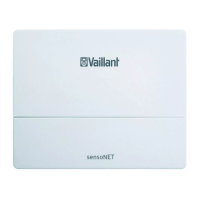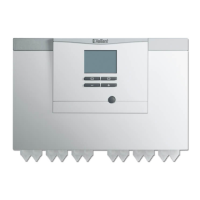Appendix
0020291573_00 Heat pump control interface module Installation instructions 31
Code Meaning Cause
Remedy
F.729 Compressor outlet temperature
too low
– The compressor outlet temperature
is lower than 0 °C for more than 10
minutes or the compressor outlet
temperature is lower than -10 °C
even though the heat pump is in the
operating characteristics.
– Checking the high-pressure sensor
– Checking that the EEV is working
correctly
– Checking for condensate leaking
from the temperature sensor (under-
cooling)
– Check whether the 4-port diverter
valve is in the intermediate position
– Checking the refrigerant volume for
overfilling
F.731 High-pressure switch open – Refrigerant pressure too high. The
integrated high-pressure switch
in the outdoor unit has tripped at
41.5 bar (g) or 42.5 bar (abs)
– Insufficient energy output via the
condenser
– Purging the building circuit
– Too low a volume flow as a result
of closing single room controls in an
underfloor heating system
– Check that the dirt filter that is in
place is permeable
– Refrigerant flow rate too low (e.g.
electronic expansion valve defective,
4-port diverter valve is mechanically
blocked, filter is blocked). Inform
customer service.
– Cooling mode: Check the fan unit for
dirt
– Check the high-pressure switch and
high-pressure sensor
– Reset the high-pressure switch and
carry out a manual reset on the
product.
F.732 Compressor outlet temperature
too high
The compressor outlet temperature is
above 110 °C:
– Application limits exceeded
– EEV does not work or does not open
correctly
– Refrigerant volume too low (frequent
defrosting due to extremely low
evaporation temperatures)
– Check the compressor inlet sensor
and outlet sensor
–
Check the compressor outlet temper-
ature sensor (TT135)
– Check the EEV (does the EEV
move to the limit stop? Use the
sensor/actuator test)
– Check the refrigerant volume (see
Technical data)
– Carry out a leak-tightness test
– Check whether the service valves on
the outdoor unit are open.
F.733 Evaporation temperature too low – Insufficient air volume flow through
the outdoor unit's heat exchanger
(heating mode) leads to an insuffi-
cient energy input in the environment
circuit (heating mode) or building cir-
cuit (cooling mode)
– Refrigerant volume too low
– If the building circuit contains ther-
mostatic valves, check that they are
suitable for cooling mode (check
volume flow in cooling mode)
– Check the fan unit for dirt
– Check the EEV (does the EEV
move to the limit stop? Use the
sensor/actuator test)
– Check the compressor inlet sensor
– Check the refrigerant volume
F.734 Condensation temperature too low – The temperature in the heating
circuit is too low, outside of the
operating characteristics
– Refrigerant volume too low
– Check the EEV (does the EEV
move to the limit stop? Use the
sensor/actuator test)
– Check the compressor inlet sensor
– Check the refrigerant filling volume
(see technical data)
– Check whether the 4-port diverter
valve is in an intermediate position
and is not correctly switched
– Checking the high-pressure sensor
– Check the pressure sensor in the
heating circuit

